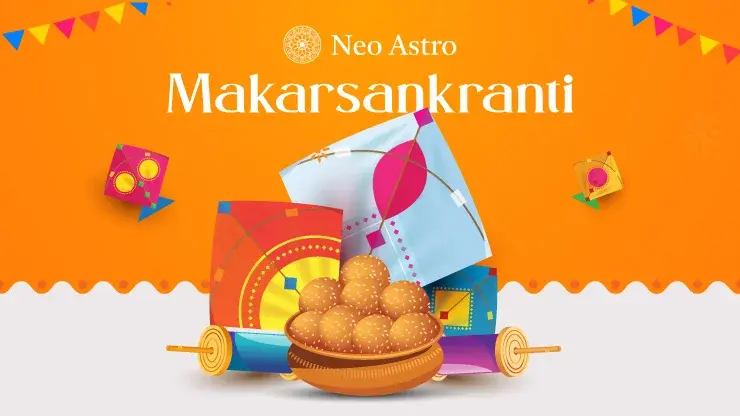Makar Sankranti 2026 – Meaning, Significance, Rituals, Celebration and More

Every January, as winter begins to loosen its hold and the first rays of longer days appear, India awakens to one of its most radiant festivals, Makar Sankranti. The aroma of til-gur sweets fills the air, kites colour the sky, and there’s an unmistakable sense of renewal all around.
Makar Sankranti holds a place of honour in the Hindu calendar. It is also a turning point in the year, a moment when the Sun begins its northward movement into Capricorn, symbolising new light and new beginnings. For farmers, it marks a time of harvest and gratitude. For spiritual seekers, it is a day of cleansing and offering.
In 2026, Makar Sankranti falls on 14 January, and people across India will celebrate it in their own unique ways. Yet the essence remains the same everywhere: gratitude for nature’s abundance, a salute to the Sun, and the joy of giving and sharing. What makes this day so spiritually charged, and how can one truly celebrate it? Let’s find it out together.
When is Makar Sankranti in 2026?
Makar Sankranti will be celebrated on Wednesday, 14 January 2026. This date is significant because it marks the exact moment when the Sun transitions from Sagittarius to Capricorn, an event known as Makara Sankraman.
The festival’s spiritual energy peaks during the Punya Kaal, which is considered the most auspicious period for rituals, bathing, and charity. In 2026, the Sankranti moment is expected to occur around the afternoon, and the Punya Kaal will last for approximately two to three hours. During this time, devotees perform Surya Arghya, take holy baths, and offer sesame, jaggery, and prayers to the Sun.
While the regional annual calendar may show slight variations in timing, the significance of the day remains constant throughout the country. It is a rare Hindu festival that is based on the solar calendar, and ensures it always falls on the same date every year, with only small astronomical differences.
Makar Sankranti 2026 Date and Time at a Glance
| Detail | Information |
| Festival Name | Makar Sankranti 2026 |
| Date (India) | Wednesday, 14 January 2026 |
| Sankranti Moment | Around 2:49 PM (IST) approximate |
| Punya Kaal Duration | About 2:49 PM to 5:45 PM (IST) |
| Maha Punya Kaal Duration | Around 2:49 PM to 3:42 PM (IST) |
| Significance | Sun’s transition into Capricorn (Makara Rashi) – start of Uttarayana |
Understanding the Meaning and Significance of Makar Sankranti
The word Makar refers to Capricorn, and Sankranti means movement or transition. Together, they describe the Sun’s journey into the zodiac sign of Capricorn. In Hindu belief, this celestial shift symbolises the start of Uttarayana, the Sun’s northward path, a period that represents enlightenment, progress, and spiritual awakening.
Spiritual Significance:
The movement of the Sun signifies the victory of light over darkness. From this day, daylight hours begin to lengthen, reminding us that even the darkest night gives way to dawn.
It marks the beginning of a phase believed to be filled with positivity and divine blessings. People are encouraged to focus on self-improvement, prayer, and acts of charity.
The act of offering water to the rising Sun, known as Arghya, symbolises surrender to the supreme energy that sustains life.
Cultural Significance:
For farmers, Makar Sankranti marks the completion of the winter crop harvest. It is a day to express gratitude for a fruitful yield.
For families, it becomes a day of bonding and togetherness, as food, sweets, and goodwill are shared freely.
For devotees, it offers an opportunity for purification through holy baths, donation, and prayer.
This festival beautifully blends the material and the spiritual. It is about honouring the physical harvest from the Earth and the inner harvest of virtues within oneself.
The Story Of Makar Sankranti - Folklore You Must Know!
Every great festival in India carries a story, and Makar Sankranti is no different. According to ancient legend, the Sun God, Surya, visited his son Shani (Saturn) on this day. Despite differences between them, the Sun put aside his pride and embraced his son. This signifies the importance of reconciliation and humility. This also highlights one of the deeper messages of the festival; the need to let go of resentment and choose peace.
Another story links Makar Sankranti to Bhishma Pitamah from the Mahabharata. It is said that Bhishma, who had the boon of choosing the time of his death, waited until the Sun began its northward journey to leave his body. He believed that souls departing during Uttarayana attain liberation more easily. Hence, the day is associated with salvation and divine passage.
In certain regions, folklore speaks of Goddess Sankranti as a deity who defeated the demon Sankarasur, symbolising the triumph of truth and virtue.
These stories collectively remind us that Makar Sankranti is not just about ritual, but about embracing change, forgiveness, and light in one’s life.
How is the Sankranti Festival Celebrated Across India?
Although Makar Sankranti carries one name, the importance of makar sankranti wears many faces across India. Each state brings its own charm, flavour, and ritual to the celebration.
In Gujarat
The day is known as Uttarayan. The sky becomes a sea of colourful kites as people gather on rooftops with family and friends. Competitions, laughter, and music fill the air. Special snacks like chikkis, undhiyu, and jalebi add sweetness to the day.
In Tamil Nadu
The festival is celebrated as Pongal, a four-day harvest celebration. The second day, known as Surya Pongal, honours the Sun. People cook freshly harvested rice in earthen pots, letting it overflow as a sign of prosperity. Sugarcane, turmeric, and flowers adorn homes, and families come together to exchange blessings.
In Maharashtra
Here, women exchange til-gur laddoos (made of sesame and jaggery) while saying, “Til-gul ghya, god-god bola”, which means “Accept these sweets and speak sweet words.” Many women wear traditional black saree for makar sankranti and meet friends in a ritual known as Haldi-Kumkum, a symbol of goodwill and unity.
In Punjab
In Punjab, the Sankranti festival is celebrated as Maghi, a vibrant occasion that follows Lohri. The day begins with devotees taking an early morning dip in sacred rivers, praying for prosperity and good health. Families gather to cook traditional kheer made of rice and jaggery. This tradition is said to fill homes with sweetness and warmth.
In Assam
In Assam, Makar Sankranti 2026 will be observed as Bhogali Bihu, one of the state’s most joyful harvest celebrations. On the eve of the festival, people build bamboo structures called Meji and light them at dawn to honour the gods. Households prepare pitha (rice cakes) and laru (sesame and coconut laddoos), which symbolise prosperity and unity.
In Odisha and West Bengal
In Odisha and West Bengal, the Makar Sankranti festival brings together faith, food, and tradition. Families prepare Makara Chaula, a sweet dish made from freshly harvested rice, coconut, banana, and jaggery, first offered to deities before sharing it with loved ones. In West Bengal, the famous Ganga Sagar Mela draws thousands of devotees who gather at the confluence of the Ganges and the sea to take a holy dip and seek blessings. The air hums with devotion and reverence, perfectly capturing the spiritual significance of Makar Sankranti as a time of purification, faith, and renewal.
Across all these celebrations flows a single current, gratitude for the Sun, the Earth, and the abundance of life. Every ritual, whether through song, food, or prayer, becomes a heartfelt tribute to the balance between humanity and nature.
Traditions and Rituals to Follow on Makar Sankranti
The Sankranti festival is filled with meaningful customs that blend devotion, gratitude, and joy. Each practice reflects the deep spiritual significance of Makar Sankranti and the bond between people, nature, and the divine.
Morning Bath and Sun Worship – The day begins before sunrise with a ritual bath, often taken in rivers or nearby water bodies. It is believed that this act purifies the mind and soul, and helps in releasing past negativity. Devotees then offer Arghya to the rising Sun using water, flowers, and sesame seeds while chanting sacred mantras to honour Surya Dev and welcome new energy into their lives.
Charity and Kindness – Sharing and caring holds special value on this day. Donating food, warm clothes, or money to those in need is considered a noble act. Offerings made with sesame and jaggery are particularly favoured, as they symbolise warmth, compassion, and the sweetness of harmonious relationships. Charity on Makar Sankranti is said to invite blessings for abundance and peace.
Traditional Foods and Feasting – Homes fill with the fragrance of festive dishes like til-gur laddoos, pongal, khichdi, and sugarcane sweets. Each food carries a symbolic message: sesame represents unity, rice stands for prosperity, and jaggery signifies peace. Families gather to enjoy these delicacies together, creating an atmosphere of love and gratitude.
Decor and Rangoli – Makar sankranti decorations ideas cover entrances decor with torans of mango leaves and bright marigolds to welcome good fortune. Colourful rangoli for makar sankranti are made on courtyards and doorways, featuring motifs of the Sun, kites, and lotuses. As evening arrives, diyas are placed at doorsteps and near home altars, spreading light that symbolises warmth, devotion, and renewal.
The Black Saree Tradition – In Maharashtra, women traditionally wear elegant black sarees on Makar Sankranti. The colour absorbs warmth during winter and represents strength, poise, and grace. Women visit one another’s homes, exchange sweets, and share festive greetings, strengthening bonds of friendship and positivity.
Kite Flying and Festive Joy – The skies come alive with vibrant kites soaring above rooftops. This cheerful custom symbolises freedom, optimism, and human aspiration. For children, it brings laughter and play; for adults, it evokes nostalgia and a sense of connection to tradition.
Family Gatherings and Gratitude – The festival offers the perfect opportunity to spend time with family and friends. People enjoy music, conversation, and shared meals, and take a moment to express gratitude for the blessings of the past year. Many also use this day to set intentions for the future, seeking spiritual clarity and inner peace.
Through these rituals and moments of joy, the true makar sankranti meaning comes alive to honour the light, to give selflessly, and to celebrate life’s abundance with gratitude and grace.
Conclusion
As the Sun begins its northward course, Makar Sankranti reminds us that every ending opens the way for renewal. Winter’s chill softens, days grow brighter, and hearts lift with hope. The festival celebrates gratitude, generosity, and the light that expands when shared. As you savour til-gur sweets or watch your kite rise against the sky, take a moment to reflect, pray, and spread kindness. For precise Makar Sankranti Muhurats and personal astrological insight, connect with trusted astrologers on the Neo Astro App and honour this day with true awareness.
Let the warmth of the Sun guide your thoughts, your home, and your spirit into a season of harmony and promise. Happy Makar Sankranti!
FAQs - Makarsankranti 2026
In which states is Makar Sankranti celebrated?

Usually, yes. Makar Sankranti is one of the few Hindu festivals based on the solar calendar, which is why it almost always falls on 14 January each year. Occasionally, due to astronomical variations, it may occur on 15 January. For Makar Sankranti 2026, the festival will be celebrated on Wednesday, 14 January 2026, with auspicious muhurats in the afternoon.
Which God is Makar Sankranti dedicated to?

Makar Sankranti is dedicated to Surya Dev, the Sun God, who represents vitality, knowledge, and spiritual light. Devotees offer Arghya (water offerings) at sunrise to express gratitude for the Sun’s life-giving energy. The significance of Makar Sankranti lies in honouring this solar transition and seeking blessings for clarity, prosperity, and health.
Is Makar Sankranti always on 14 January?

Usually, yes. Makar Sankranti is one of the few Hindu festivals based on the solar calendar, which is why it almost always falls on 14 January each year. Occasionally, due to astronomical variations, it may occur on 15 January. For Makar Sankranti 2026, the festival will be celebrated on Wednesday, 14 January 2026, with auspicious muhurats in the afternoon.
Which God is Makar Sankranti dedicated to?

Makar Sankranti is dedicated to Surya Dev, the Sun God, who represents vitality, knowledge, and spiritual light. Devotees offer Arghya (water offerings) at sunrise to express gratitude for the Sun’s life-giving energy. The significance of Makar Sankranti lies in honouring this solar transition and seeking blessings for clarity, prosperity, and health.
Why do people wear black on Makar Sankranti?

In Maharashtra, wearing a black saree for makar sankranti is both cultural and practical. The colour absorbs warmth during the cool January mornings and symbolises strength and confidence. Women also exchange til-gur sweets while sharing good wishes, reflecting the makar sankranti meaning of unity, kindness, and positivity.
What is the special food of Makar Sankranti?

Food plays a beautiful role in this festival. Traditional dishes like til-gur laddoos, pongal, khichdi, and sugarcane sweets are prepared in homes across India. Sesame (til) and jaggery (gur) hold special importance, they signify warmth, sweetness, and the bond of togetherness. Sharing these delicacies is considered an auspicious act during the Sankranti festival.
What is the scientific reason behind celebrating Makar Sankranti?

Scientifically, Makar Sankranti marks the time when the Sun moves into the zodiac sign of Capricorn and begins its northward journey, known as Uttarayana. This shift results in longer days and increased daylight, signalling the end of winter. The festival therefore celebrates the change of season and the renewal of energy in both nature and the human spirit.
